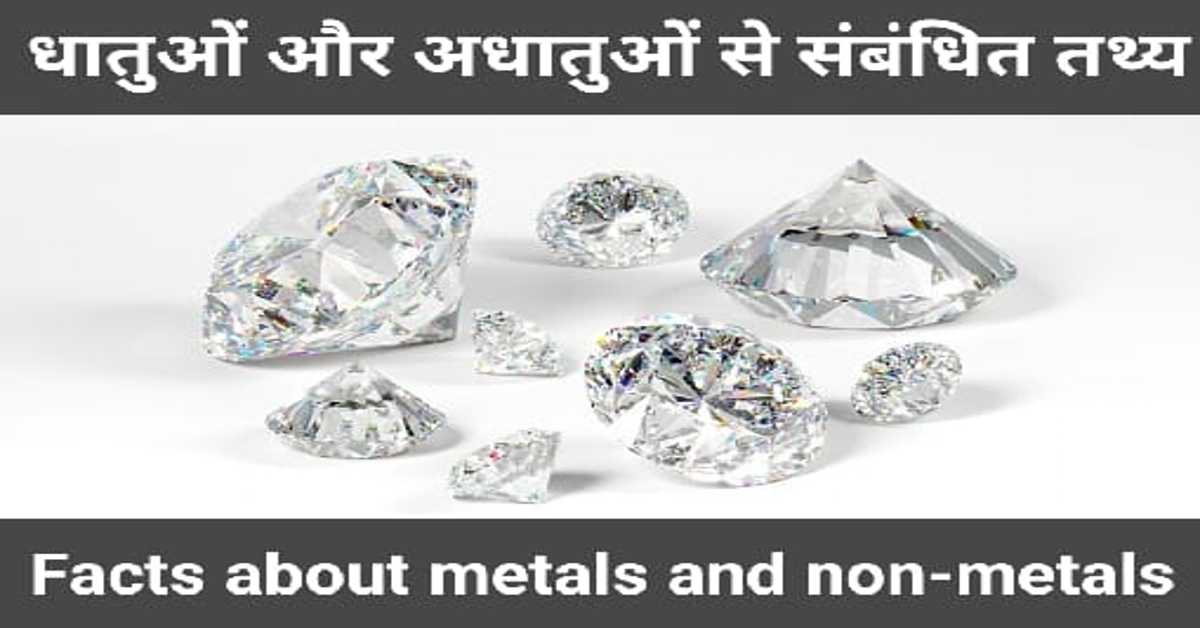
धातुओं और अधातुओं से संबंधित तथ्य | Facts about metals and non-metals
प्रकृति में धातुओं की संख्या अधातुओं की तुलना में अधिक है। प्रकृति के कुछ महत्वपूर्ण अधातु कार्बन, सल्फर, आयोडीन, ऑक्सीजन और हाइड्रोजन हैं। ब्रोमीन भी एक अधातु है। यह द्रव अवस्था में रहती है। इसके अतिरिक्त समस्त अधातुएँ ठोस अथवा गैस अवस्था में रहती हैं। केवल भौतिक गुणधर्मों के आधार पर ही तत्वों को वर्गीकृत नहीं किया जा सकता। सभी धातुएँ ठोस अवस्था में रहती हैं। केवल मरकरी एक ऐसा धातु है, जो कमरे के ताप पर द्रव अवस्था में रहती है। धातुओं का गलनांक बहुत अधिक होता है। गैलियम और सीज़ियम का गलनांक बहुत कम है। यदि इन धातुओं को हथेली पर रखा जाए तो ये पिघलने लगती हैं।
The number of metals in nature is more than that of non-metals. Some of the important non-metals in nature are carbon, sulphur, iodine, oxygen and hydrogen. Bromine is also a nonmetal. It remains in liquid state. Apart from this, all non-metals remain in solid or gas state. Elements cannot be classified on the basis of physical properties alone. All metals remain in the solid state. Mercury is the only metal that exists in a liquid state at room temperature. Metals have very high melting points. Gallium and cesium have very low melting points. If these metals are kept on the palm, they start melting.
रसायन विज्ञान के इन 👇 प्रकरणों को भी पढ़ें। (Also read these 👇 episodes of Chemistry.)
धातुएँ– भौतिक गुणधर्म | Metals– Physical Properties
अधिकांश अधातुएँ चमकहीन होती हैं। आयोडीन एक अधातु है, किंतु फिर भी यह चमकीला होता है। कार्बन एक अधातु है। यह विभिन्न रूपों में रहती है। कार्बन के प्रत्येक रूप को 'अपररूप' कहा जाता है। हीरा, कार्बन का ही एक अपरूप है। यह प्रकृति का सबसे कठोर पदार्थ है। हीरे का गलनांक और क्वथनांक बहुत अधिक होता है। इसके अलावा कार्बन का अन्य अपररूप ग्रेफाइट है। यह विद्युत का सुचालक है।
Most non-metals are lustrous. Iodine is a non-metal, but still it is lustrous. Carbon is a nonmetal. It lives in various forms. Each form of carbon is called a 'alloform'. Diamond is an allotrope of carbon. It is the hardest substance in nature. Diamond has a very high melting point and boiling point. Apart from this, the other allotrope of carbon is graphite. It is a good conductor of electricity.
रसायन विज्ञान के इन 👇 प्रकरणों को भी पढ़ें। (Also read these 👇 episodes of Chemistry.)
क्रिस्टलन का जल– जिप्सम और प्लास्टर ऑफ पेरिस | Water Of Crystallisation– Gypsum And Plaster Of Paris
सोडियम, लीथियम और पोटेशियम, ये सभी धातुएँ हैं। ये मुलायम होती हैं। इन्हें चाकू से भी काटा जा सकता है। इनके घनत्व और गलनांक न्यूनतम होते हैं। प्रकृति के तत्वों को उनके रासायनिक गुणधर्मों के आधार पर धातुओं एवं अधातुओं में बाँटा जा सकता है। अधिकतर अधातुएँ ऑक्साइड प्रदान करते हैं, जो जल में घुलकर अम्ल का निर्माण करते हैं। अधिकतर धातुएँ क्षारकीय ऑक्साइड देते हैं।
Sodium, lithium and potassium are all metals. They are soft. They can also be cut with a knife. They have minimum densities and melting points. The elements of nature can be divided into metals and non-metals on the basis of their chemical properties. Most non-metals give oxides, which dissolve in water to form acids. Most metals give basic oxides.
रसायन विज्ञान के इन 👇 प्रकरणों को भी पढ़ें। (Also read these 👇 episodes of Chemistry.)
धोने का सोडा– निर्माण एवं उपयोग | Washing Soda– Manufacture And Uses
आशा है, उपरोक्त जानकारी आपके लिए उपयोगी होगी।
धन्यवाद।
R F Temre
rfcompetition.com
आशा है, उपरोक्त जानकारी उपयोगी एवं महत्वपूर्ण होगी।
(I hope the above information will be useful and important. )
Thank you.
R. F. Tembhre
(Teacher)
pragyaab.com




Comments